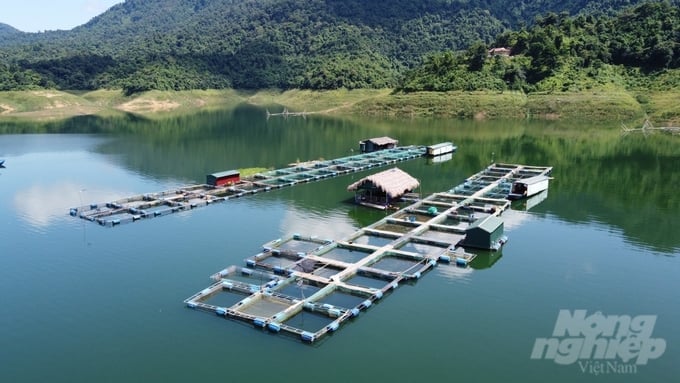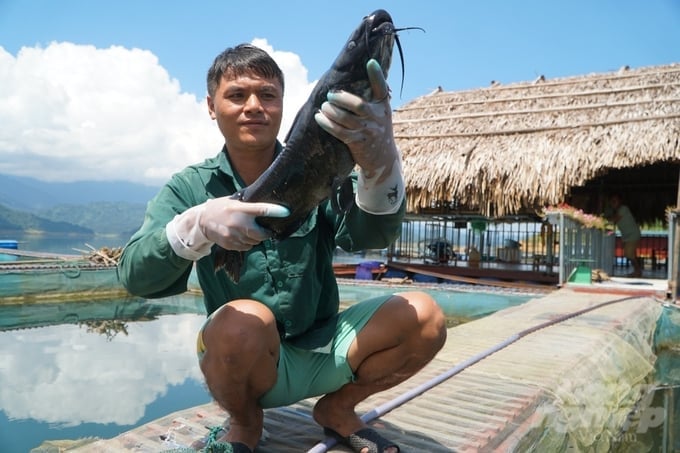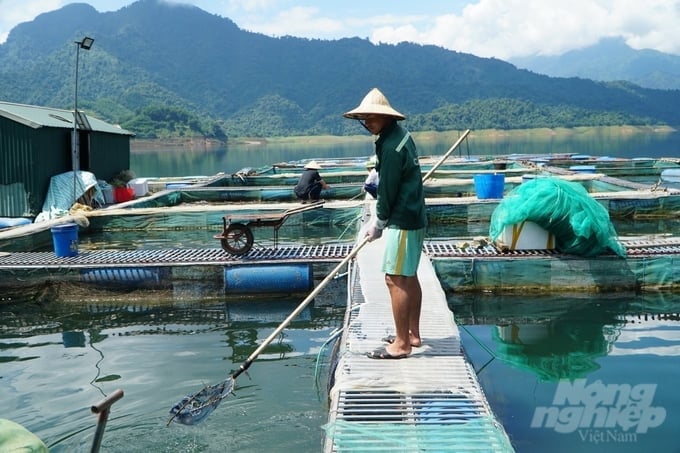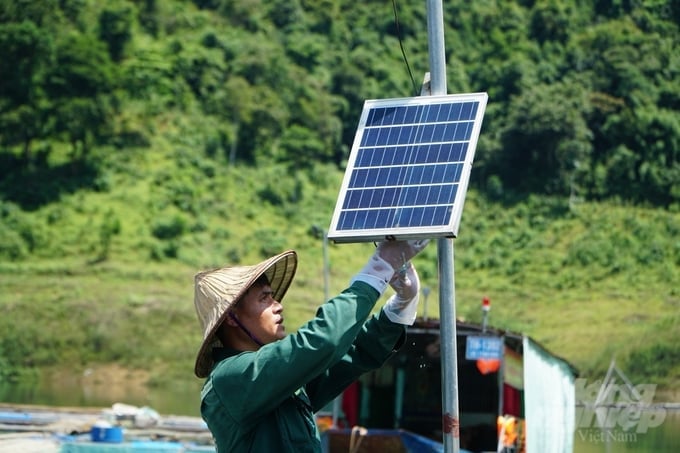May 17, 2025 | 03:15 GMT +7
May 17, 2025 | 03:15 GMT +7
Hotline: 0913.378.918
May 17, 2025 | 03:15 GMT +7
Hotline: 0913.378.918

Cage fish farming in combination with ecotourism represents a new direction in the development of agricultural production, thereby contributing to the increased income of local residents. Photo: Tam Phung.
The long-standing practice of cage fish farming in Thuong Xuan district, Thanh Hoa province has been rapidly developing in recent years. Following the district's initiative to promote cage fish farming on the hydroelectric reservoir, Mr. Nguyen Van Sinh from Ngoc Phung commune, Thuong Xuan district made the decision to invest in fish cages on the reservoir of the Cua Dat hydroelectric plant in 2018. Mr. Sinh is among the few households pioneering the combination of cage fish farming and eco-tourism in the district.
Due to a lack of farming experience, he initially encountered significant difficulties in terms of disease prevention and control. "Fish raised in a natural environment are highly susceptible to diseases such as fin rot and fungal infections. Without immediate treatment, the entire cage of fish can die within a few days. Due to lack of experience, between 2019 and 2020, I lost several tons of river catfish and helicopter catfish, which amounted to a loss of hundreds of millions of Vietnamese dong," Mr. Sinh recalled.
Most notably, his cages of helicopter catfish died en masse due to a lack of understanding with regards to the behavior of the fish. "Helicopter catfish usually feed on other fish and live at the bottom of the pond. However, the fish will not respond when farmers distribute powdered feed on the water's surface. Due to starvation, the fish will begin attacking one another, causing substantial damage. Mr. Sinh reported an incident whereby one of his fish cages was damaged, releasing 3 tons of catfish into the reservoir, and resulting in a loss of hundreds of millions of Vietnamese dong.
After a difficult process of trial and error, Mr. Sinh became more skilled in the slection of fish breeds, fish farming techniques, and net cage construction. According to Mr. Sinh, the breed is the decisive factor in productivity and yield. "The breed must be healthy, visually appealing, and show no signs of skin diseases. Only a good breed can provide a healthy and strong fish," he explained.

The Red Tilapia is considered the main farmed fish at Cua Dat reservoir. Photo: Quoc Toan.
Mr. Sinh currently operates 20 fish cages, with the primary products being catfish, black tilapia, and red tilapia. The average annual output is estimated at between 20 and 30 tons. After deducting expenses, Mr. Sinh earns an annual revenue of approximately 400 to 500 million Vietnamese dong. With the aim of expanding the fish farming model on the hydroelectric reservoir, Mr. Sinh, and 16 other households, established a cooperative group specializing in aquaculture services at Cua Dat.
Additionally, the cooperative group collaborates with an additional 16 households, providing them with fish breeds and assisting in product distribution. In addition to seeking markets for product consumption, the cooperative is a platform where participating households share experiences in cage fish farming, with a focus on protecting the aquaculture area and the water environment within the reservoir.
"The current market for cage fish is relatively stable. The majority of harvested fish are directly bought by traders. The cooperative currently operates 106 fish cages, with a yield of 100 tons in 2022. With the selling price of catfish at the reservoir ranging from 100,000 to 110,000 Vietnamese dong per kilorgam, and red tilapia at 50,000 to 60,000 Vietnamese dong per kilorgam, the estimated annual revenue is over tens of billion Vietnamese dong," Mr. Sinh reported.
The effectiveness of cage fish farming on the hydroelectric reservoir has allowed many local workers to achieve a stable income between 6 and 8 million Vietnamese dong per month.

The current market for cage fish is relatively stable. Photo: Quoc Toan.
In addition to collectively developing cage fish farming, Mr. Nguyen Van Sinh established Cua Dat Eco-Tourism Company to utilize the potential and advantages of the reservoir area. Accordingly, the company is designed to utilize the area's strengths for both fish farming and tourism.
Despite the relatively young age of the combined model of cage fish farming and eco-tourism, it represents a promising direction that utilizes local advantages to improve the income of the local community. With the goal of boosting the effectiveness of this collaboration and enhancing economic prospects, Mr. Sinh and local households have proactively invested in six tourist boats to serve visitors. These boats facilitate transportation for tourists to various points of interest within the Cua Dat reservoir area, providing onboard dining experiences, tours of the fish farming zones, and serving dishes made from the locally farmed fish.
According to the Thuong Xuan District People's Committee, the combined model of cage fish farming and eco-tourism has created employment opportunities for over 80 local workers, thereby contributing to stabilizing the socio-economy of the Cua Dat reservoir area. Reportedly, there are 166 aquaculture cages on the Cua Dat reservoir, including 100 VietGAP-compliant cages with an annual yield of 300 tons.

Cage fish farming creates stable employment opportunities and income for many local workers. Photo: Quoc Toan.
Outside of Thuong Xuan district, the cage fish farming model in hydroelectric reservoirs is a new direction embraced by residents in the mountainous Quan Hoa district, contributing to poverty alleviation, increased income, and an improved standard of living for the locals.
Presently, at least 50 households in the district have engaged in cage fish farming, with over 100 fish cages, primarily concentrated in the Trung Son hydroelectric reservoir. The district is aiming to ttract investments in raising economically valuable specialty fish species. On the ther hand, the district is formulating plans to develop concentrated aquaculture areas in addition to preventing uncontrolled, environmentally polluting spontaneous fish farming activities.
Similarly, 74 households in Dien Lu commune, Ba Thuoc district are currently engaged in cage fish farming in Ba Thuoc 1 and 2 hydroelectric reservoirs with over hundreds of fish cages. To boost productivity and yield, the local government has organized training sessions and provided technical assistance to fish farmers in the selection of fish breeds.
According to statistics from the Thanh Hoa province's Department of Agriculture and Rural Development, there are approximately 138 hectares of cage fish farming across the province. This figure includes 50 hectares of freshwater cage fish farming area in hydroelectric reservoirs with 2,139 cages, and 88 hectares for saltwater and brackish water cage fish farming area with 4,000 cages. These farming cages are located in the estuarine area leading to the coastal zone within Nghi Son town.
In order to enhance economic efficiency, local residents have diversified the range of farmed fish species. For freshwater cage fish farming, in addition to the traditional species of carp, tilapia, black tilapia, red tilapia, grass carp, and catfish, locals have also developed several specialty breeds including goby, Anh Vu fish, devil catfish, etc. For saltwater and brackish water cage fish farming, farmers have extended their breed range to include gourami, golden pomfret, red snapper, grouper, mullet, barramundi, ornamental fish, lobsters, and sea snails.

The Cua Dat hydroelectric reservoir currently houses 166 aquaculture cages, including 100 VietGAP-compliant cages. Photo: Quoc Toan.
In conjunction with the expansion of farming areas, local residents have focused on developing commercial-scale cage fish farming in association with product consumption linkages. Furthermore, they are transitioning to industrial-scale cage farming in a sustainable and eco-friendly manner, with the aim of producing high-quality, branded products that meet market demands both domestically and internationally.
According to the Thanh Hoa province's Department of Agriculture and Rural Development, the potential for commercial aquaculture on hydroelectric reservoir will contribute to the transformation of the production structure. This will aid in the development of local socio-economy and improvement of people's livelihoods.

Solar energy panels provide electricity to the fish cages. Photo: Tam Phung.
The Agriculture and Rural Development sector in Thanh Hoa province is advising local governments to encourage the expansion of cage fish farming on hydroelectric reservoirs. Moreover, the sector is implementing strategies to attract further investment in scaling up the commercial aspect of cage fish farming. This involves applying scientific and technological advances in the farming process, establishing plans for the concentrated development of aquaculture areas, and preventing uncontrolled, environmentally polluting spontaneous fish farming activities.
Despite the advantages, the expansion of the cage fish farming model encounters several challenges. These include insufficient investment capital and outdated production habits among the local population, resulting in limitations in the application of scientific and technological advancements. Consequently, there is a need for increased support from various levels of the government to facilitate the sustainable development of cage fish farming. This effort will yield high economic efficiency, contribute to poverty reduction, and aid in new rural construction.
With the aim of effectively utilizing water surfaces for cage fish farming as a large-scale commodity production industry, Thanh Hoa Provincal People's Committee issued Decision No. 4716/QD-UBND on December 28, 2022, approving the development plan for cage fish farming in Thanh Hoa province until 2025, with a vision towards 2030.
The objectives of this plan are to increase the scale of production and transition towards sustainable, safe, efficient, and environmentally friendly industrial cage fish farming. Subsequently, the plan will generate high-quality, branded products meeting market demands domestically and internationally. Moreover, it aims to create employment opportunities, stabilize livelihoods, and elevate the income of local residents, with an emphasis on those in mountainous and coastal rural areas.
Translated by Nguyen Hai Long

(VAN) Cold-barn systems efficiently manage environmental and temperature conditions, which aids in the prevention of respiratory diseases in pigs and protects them from the vectors that transmit African swine fevers.

(VAN) To tackle challenges, the project 'Addressing key technical bottlenecks in the grouper supply chain in Vietnam' has been underway since 2024.

(VAN) The project 'Disease-Resilient and Sustainable Cassava Production Systems in the Mekong Region', funded by the Australian Center for International Agricultural Research (ACIAR), is being implemented from 2024 to 2028.

(VAN) Data from 10,000 farming households will help professionalize production organization and support the implementation of the One Million Hectares Program for High-Quality, Low-Emission Rice Cultivation.

(VAN) FAO Director-General QU Dongyu marks International Day of Plant Health at NENA conference.

(VAN) Deputy Minister of Agriculture and Environment Hoang Trung affirmed that floriculture and ornamental plants are a growing industry that receives significant global attention.

(VAN) The three staple crops dominating modern diets – corn, rice and wheat – are familiar to Americans. However, fourth place is held by a dark horse: cassava.